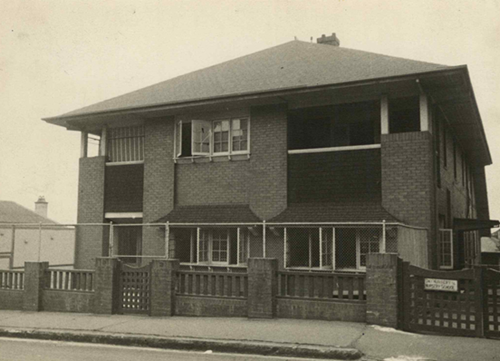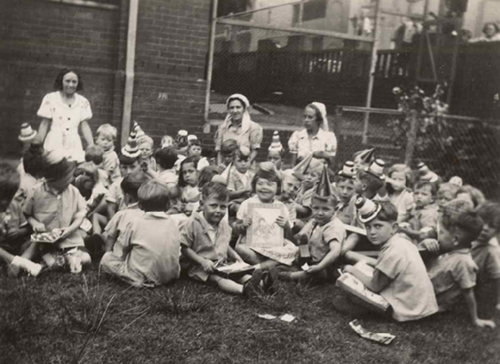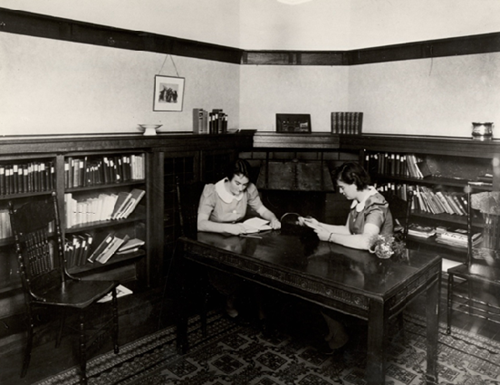Beginnings of SDN Linthorpe St, Newtown
Instead of the parents putting the children into institutions […] the children have been well cared for and fed each day in the nurseries, the family has been kept together.' Sydney Day Nursery Association Annual Report 1933-34
SDN Children's Services begins in 1905
In 1905 a determined group of women from Sydney’s upper classes who understood ‘the difficulties that beset the paths of working mothers’ founded the Sydney Day Nursery Association (now SDN Children’s Services). The Association aimed to improve the welfare of children whose mothers were facing poverty and had to work to provide for their family. Infant mortality was high and the Kindergarten Union was only able to provide day care services for a few hours a day. With no other option, these young children were often left to fend for themselves among the streets of working class Sydney.
In response, the Association opened its first Day Nursery in a terrace house in Dowling Street, Woolloomooloo in 1905, the first long day care centre in NSW. For just three pence a day, babies and children were bathed, fed, clothed and cared for from 7.00am to 6.30pm.
Due to overwhelming demand, the Association opened Day Nurseries in other locations in the inner city soon after. These were all areas of need in Sydney with large working populations.
History of Newtown
The traditional owners of the area are the Gadigal people of the Eora nation [1].
In the early years of Sydney the area was developed as farmland. King Street was originally called Bulanaming Road, following an existing Aboriginal track.
A settlement of buildings and businesses formed along the road and was given the name New Town in the early 1830s, possibly from the local ‘New Town’ grocery store. Newtown became one of the first major shopping centres outside of Sydney Town.
1855, the Great Western Railway line to Parramatta was opened with a stop at Newtown. Newtown Bridge, over the Railway Station, became a meeting place for political rallies and ‘soapbox’ speakers in the early 1900s.
In 1862, Newtown was officially named as a municipality. By the 1920s, the area was mostly industrial, with factory workers living in small crowded terrace housing.

The Newtown and District Day Nursery building, shortly after opening in 1930. Source: SDN Archive
SDN plans a Day Nursery in Newtown
The Association had long recognised the need for nurseries in the working class inner west area. After a few years of searching the crowded suburb, the building at 3 Linthorpe Street was purchased for £3,500 in December 1929. Its proximity to public transport meant it could be accessed easily by working mothers in Newtown and the neighbouring suburbs.
The building had originally been purpose built by physician and surgeon Dr McClelland in the early 1920s as a home and medical surgery, in the simplified Federation Arts and Crafts architectural style.
It was in very good condition with a large garden play area, and needed few alterations to make it a Day Nursery.

Outdoor party at Newtown Day Nursery and Nursery School, c. 1944. Source: SDN Archive
Newtown and District Day Nursery opens in 1930!
The Newtown and District Day Nursery was officially opened before a crowd of 200 people by the Sydney Day Nursery Association's Patroness, Lady Game, on 19 November 1930.
In attendance was Lady MacCallum, the President of the Association. Other guests who spoke were the Mayor and Mayoress of Newtown and Miss Ruby Board who was the acting President of the National Council of Women.
The Great Depression took hold around the same time, and unemployment rose dramatically in the area. Newtown was so affected that an anonymous donor provided accommodation at the nursery for up to three women at a time who were ‘experiencing the anxieties attendant on unemployment’.
The previous owner of the building, Dr McClelland, had moved just across the street from the nursery and provided medical services and assistance in emergencies for many years.
The original interior design featured the colour blue — blue chairs, tables and white cots with blue bed covers. The children were even dressed in blue overalls. In the blue bathrooms were low basins, and individual pegs held blue and white towels, encouraging independence within the children.
Fundraising by SDN’s Newtown Committee was an important source of income, which included a tuck shop at the East Sydney Technical College, the letting of the tennis court that came with the building, jumble sales, dances, bridge parties and fêtes.
‘We feel like we should like to have a day nursery in every suburb where working mothers live, for they assist by giving children education […] and by helping to keep in employment the mothers’ Lady MacCallum at the opening of the Newtown & District Day Nursery, The Sydney Morning Herald, 20 November, 1930

Students at the Nursery School Training College at 3 Linthorpe Street, c. 1940s. Source: SDN Archive
Nursery School education
In the early 1930s, the Association was the first in NSW to pioneer nursery schools and a training college for nursery school teachers. Nursery schools provided an educational program for children aged two to five years in a long day care setting.
In 1937, an extension was added to the back area of the Linthorpe Street building to accommodate a new Nursery School.
From 1941 to 1945 the building served as a home to the Association's Nursery School Training College. Afterwards it was used as College student accommodation and during this period the children were relocated to other centres. With the end of the College accommodation in the early 1970s, the building was free to welcome back babies and toddlers, once more becoming a community hub.
In recent times, the Ngara Nanga Mai Resource Library and Gathering Room were initially opened at SDN Linthorpe Street to provide a culturally safe space for SDN’s Aboriginal staff members, children and families. The site is also home to The Creation Snake, created by Gangari artist Kathryn Dodd Farrawell (Aunty Kathy).
SDN Linthorpe Street today
Since its beginnings, SDN Linthorpe Street has undergone many changes, reflecting a strong connection with our families within a vibrant and diverse community.
The changes in the sector to increase the quality of early childhood education and care have confirmed our own approach to professional skilled staff and services since our beginnings.
What hasn’t changed is our vision and commitment to addressing social inequalities, improving children’s quality of life and enhancing the life chances for all children.

Above: Children at SDN Linthorpe St, 2018. Photographer: Anna Zhu
About this history and the SDN Archive
This history was put together from documents held in the SDN Archive, and information from the City of Sydney Council, Inner West Council and the Dictionary of Sydney. The SDN Archive, established in 2002, is a unique resource in Australia’s early childhood education sector. SDN Children’s Services runs 26 children’s education and care centres throughout NSW and the ACT, as well as offering disability services for children and young people, and delivering government funded programs supporting children and families and other sector organisations.
[1] Spelling sourced from: City of Sydney Council.

